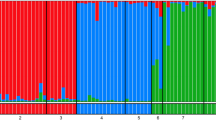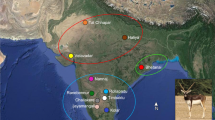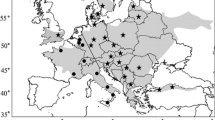Abstract
To better understand the evolutionary history of oriental wildlife newcomers in Europe, we studied the phylogeography and demographic history of the striped field mouse, Apodemus agrarius, throughout its Palaearctic distribution area. Genetic datasets including cytochrome b gene sequences and microsatellite markers were analysed using a large range of population genetics methodologies, including coalescent models and approximate Bayesian computations. Our results showed high mitochondrial genetic homogeneity among A. agrarius populations throughout the Palaearctic region, but microsatellite markers detected a finer population structure with the genetic differentiation of populations from the Eastern and Western distribution ranges. The Western colonisation likely originated from Far East Russian populations during one of the last interglacials. After their colonisation of the Central Asia and Western regions, the Central Palaearctic populations became isolated from their Eastern relatives. Our coalescent-based approaches suggested a separation between these two distribution ranges around 38 kya or more recently (around 11 kya). Limited gene flow still happened between populations in the two main distribution ranges, mainly from the Eastern to Western populations. Our study, for the first time, provides an overview of the evolutionary and demographic history of the striped field mouse throughout the Palaearctic region. A. agrarius appears to be an Asiatic immigrant and a relatively new member of the European fauna community. This study further confirms the important role of Far East Asian regions as a source of European biodiversity.




Similar content being viewed by others
References
Aguilar J-P, Pélissié T, Sigé B, Michaux J (2008) Occurrence of the stripe field mouse lineage (Apodemus agrarius Pallas 1771; Rodentia; Mammalia) in the Late Pleistocene of southwestern France. C R Palevol 7:217–225
Andersen LW, Jacobsen M, Vedel-Smith C, Jensen TS (2017) Mice as stowaways? Colonization history of Danish striped field mice. Biol Lett 13:20170064
Atopkin DM, Bogdanov AS, Chelomina GN (2007) Genetic variation and differentiation in striped field mouse Apodemus agrarius inferred from RAPD-PCR analysis. Russ J Genet 43:665–676
Bakker ES, Gill JL, Johnson CN, Vera FWM, Sandom CJ, Asner GP, Svenning J-C (2016) Combining paleo-data and modern exclosure experiments to assess the impact of megafauna extinctions on woody vegetation. Proc Natl Acad Sci 113:847–855
Bandelt HJ, Forster P, Rohl A (1999) Median-joining networks for inferring intraspecific phylogenies. Mol Biol Evol 16:37–48
Batuyev AR, Buyantuyev AB, Snytko VA (2000) Geosistemy i kartografirovaniye ekologo-geograficheskikh situatsiy Priselenginskikh kotlovin Baykalskogo regiona [The geosystems and mapping of the ecogeographical situations of the Priselenginsk depressions of the Baikal region]. Novosibirsk
Bazhenov YA, Pavlenko MV, Korablev VP, Kardash AI (2015) Current distribution of the striped field mouse (Apodemus agrarius Pallas, 1771) in Eastern Transbaikalia: new findings in the disjunction area. Russ J Biol Invasions 6:1–5
Chapuis MP, Estoup A (2007) Microsatellite null alleles and estimation of population differentiation. Mol Biol Evol 24:621–631
Corbet GB (1978) The mammals of the palaearctic region: a taxonomic review. British Museum (Natural History) and Cornell University Press, London, Ithaca
Deffontaine V, Libois R, KotlÍK P, Sommer R, Nieberding C, Paradis E, Searle JB, Michaux JR (2005) Beyond the Mediterranean peninsulas: evidence of central European glacial refugia for a temperate forest mammal species, the bank vole (Clethrionomys glareolus). Mol Ecol 14:1727–1739
Deffontaine V, Ledevin R, Fontaine MC, Quere JP, Renaud S, Libois R, Michaux JR (2009) A relict bank vole lineage highlights the biogeographic history of the Pyrenean region in Europe. Mol Ecol 18:2489–2502
Dietrich W, Katz H, Lincoln SE, Shin HS, Friedman J, Dracopoli NC, Lander ES (1992) A genetic map of the mouse suitable for typing intraspecific crosses. Genetics 131:423–447
Erbajeva MA, Khenzykhenova FI, Alexeeva NV (2013) Aridization of the Transbaikalia in the context of global events during the Pleistocene and its effect on the evolution of small mammals. Quat Int 284:45–52
Evanno G, Regnaut S, Goudet J (2005) Detecting the number of clusters of individuals using the software STRUCTURE: a simulation study. Mol Ecol 14:2611–2620
Excoffier L, Lischer HEL (2010) Arlequin suite ver 3.5: a new series of programs to perform population genetics analyses under Linux and Windows. Mol Ecol Res 10:564–567
Fedorov VB, Goropashnaya AV, Boeskorov GG, Cook JA (2008) Comparative phylogeography and demographic history of the wood lemming (Myopus schisticolor): implications for late Quaternary history of the taiga species in Eurasia. Mol Ecol 17:598–610
Fischer S, Mayer-Scholl A, Imholt C, Spierling NG, Heuser E, Schmidt S, Reil D, Rosenfeld UM, Jacob J, Nöckler K, Ulrich RG (2018) Leptospira genomospecies and sequence type prevalence in small mammal populations in Germany. Vector-Borne Zoonotic Dis 18:188–199
Fletcher WJ, Sánchez Goñi MF, Allen JRM, Cheddadi R, Combourieu-Nebout N, Huntley B, Lawson I, Londeix L, Magri D, Margari V, Müller UC, Naughton F, Novenko E, Roucoux K, Tzedakis PC (2010) Millennial-scale variability during the last glacial in vegetation records from Europe. Quat Sci Rev 29:2839–2864
Fontaine MC, Tolley KA, Michaux JR, Birkun A, Ferreira M, Jauniaux T, Llavona Á, Öztürk B, Öztürk AA, Ridoux V, Rogan E, Sequeira M, Bouquegneau J-M, Baird SJE (2010) Genetic and historic evidence for climate-driven population fragmentation in a top cetacean predator: the harbour porpoises in European water. Proc R Soc B Biol Sci 277:2829–2837
Gajda E, Hildebrand J, Sprong H, Buńkowska-Gawlik K, Perec-Matysiak A, Coipan EC (2017) Spotted fever rickettsiae in wild-living rodents from south-western Poland. Parasites Vectors 10:413
Gortat T, Rutkowski R, Gryczynska-Siemiatkowska A, Kozakiewicz A, Kozakiewicz M (2013) Genetic structure in urban and rural populations of Apodemus agrarius in Poland. Mamm Biol Zeitschrift für Säugetierkunde 78:171–177
Goudet J (2001) FSTAT, a program to estimate and test gene diversities and fixation indices (version 2.9.3). http://www.unil.ch/izea/softwares/fstat.html. Updated from Goudet (1995)
Gromov I, Erbajeva M (1995) The mammals of Russia and adjacent territories; lagomorphs and rodents, vol 167. Russian Academy of Science, Zoological Institute, St Petersburg, p 529
Guindon S, Dufayard JF, Lefort V, Anisimova M, Hordijk W, Gascuel O (2010) New algorithms and methods to estimate maximum-likelihood phylogenies: assessing the performance of PhyML 3.0. Syst Biol 59:307–321
Hall TA (1999) BioEdit: a user-friendly biological sequence alignment editor and analysis program for Windows 95/98/NT. Nucl Acids Symp Ser 41:95–98
Hasegawa M, Kishino H, Yano T-A (1985) Dating of the human-ape splitting by a molecular clock of mitochondrial DNA. J Mol Evol 22:160–174
Herman JS, Paupério J, Alves PC, Searle JB (2014) Land bridge calibration of rates of molecular evolution in a widespread rodent. In: Pontarotti P (ed) Evolutionary biology: genome evolution, speciation, coevolution and origin of life. Springer International Publishing, Berlin, pp 69–86
Herman JS, Jóhannesdóttir F, Jones EP, McDevitt AD, Michaux JR, White TA, Wójcik JM, Searle JB (2016) Post-glacial colonization of Europe by the wood mouse, Apodemus sylvaticus: evidence of a northern refugium and dispersal with humans. Biol J Linn Soc 120(2):313–332
Hewitt GM (2000) The genetic legacy of the Quaternary ice ages. Nature 405:907–913
Hey J, Nielsen R (2004) Multilocus methods for estimating population sizes, migration rates and divergence time, with applications to the divergence of Drosophila pseudoobscura and D. persimilis. Genetics 167:747–760
Hudson RR (2002) Generating samples under a Wright–Fisher neutral model of genetic variation. Bioinformatics 18:337–338
Hughes ALC, Gyllencreutz R, Lohne ØS, Mangerud J, Svendsen JI (2016) The last Eurasian ice sheets—a chronological database and time-slice reconstruction, DATED-1. Boreas 45:1–45
Kartavtseva IV, Pavlenko MV (2000) Chromosomal variability of the field mouse Apodemus agrarius (Rodentia, Muridae). Genetika 36:223–236
Kim HR, Park YC (2015) Genetic diversity and genetic structure of the striped field mouse Apodemus agrarius coreae (Muridae, Rodentia) in Korea. Gene 572:292–297
Klempa B, Avsic-Zupanc T, Clement J, Dzagurova TK, Henttonen H, Heyman P, Jakab F, Kruger DH, Maes P, Papa A, Tkachenko EA, Ulrich RG, Vapalahti O, Vaheri A (2013) Complex evolution and epidemiology of Dobrava-Belgrade hantavirus: definition of genotypes and their characteristics. Arch Virol 158:521–529
Kocher TD, Thomas WK, Meyer A, Edwards SV, Pääbo S, Villablanca FX, Wilson AC (1989) Dynamics of mitochondrial DNA evolution in animals: amplification and sequencing with conserved primers. Proc Natl Acad Sci 86:6196–6200
Koh HS, Csorba G, Tiunov MP, Tikhonova G (1998) Morphometric analyses of the three subspecies of striped field mouse, Apodemus agrarius Pallas (Mammalia: Rodentia) from Far Eastern Asia: taxonomix status of North Korean striped field mice. Korean J Syst Zool 14:327–334
Koh HS, Shaner PJ, Csorba G, Wang Y, Jang KH, Lee JH (2014) Comparative genetics of Apodemus agrarius (Rodentia: Mammalia) from insular and continental Eurasian populations: cytochrome b sequence analyses. Acta Zool Acad Sci Hung 60:73–84
Kopelman NM, Mayzel J, Jakobsson M, Rosenberg NA, Mayrose I (2015) Clumpak: a program for identifying clustering modes and packaging population structure inferences across K. Mol Ecol Res 15:1179–1191
Kraljik J, Paziewska-Harris A, MiklisovÁ D, Blaňarová L, Mošanský L, Bona M, Stanko M (2016) Genetic diversity of Bartonella genotypes found in the striped field mouse (Apodemus agrarius) in Central Europe. Parasitology 143:1437–1442
Lalis A, Leblois R, Liefried S, Ouarour A, Reddy Beeravolu C, Michaux J, Hamani A, Denys C, Nicolas V (2016) New molecular data favour an anthropogenic introduction of the wood mouse (Apodemus sylvaticus) in North Africa. J Zool Syst Evol Res 54:1–12
Lorenzini R, Garofalo L, Qin X, Voloshina I, Lovari S (2014) Global phylogeography of the genus Capreolus (Artiodactyla: Cervidae), a Palaearctic meso-mammal. Zool J Linn Soc 170:209–221
Makova KD, Patton JC, Krysanov EY, Chesser RK, Baker RJ (1998) Microsatellite markers in wood mouse and striped field mouse (genus Apodemus). Mol Ecol 7:247–255
Michaux JR, Magnanou E, Paradis E, Nieberding C, Libois R (2003) Mitochondrial phylogeography of the Woodmouse (Apodemus sylvaticus) in the Western Palearctic region. Mol Ecol 12:685–697
Navascués M (2017) microsatABC-IM: Approximate Bayesian computation inferences under the isolation with migration model from microsatellite data (Version v1.0). Zenodo
Neumann K, Michaux JR, Maak S, Jansman HAH, Kayser A, Mundt G, Gattermann R (2005) Genetic spatial structure of European common hamsters (Cricetus cricetus)—a result of repeated range expansion and demographic bottlenecks. Mol Ecol 14:1473–1483
Okulova NM, Duvanova IA, Kalinkina EV, Mironova TA, Nedosekin VY, Drozdova VF (2012) On the ecology of striped field mouse (Apodemus agrarius Pall., 1771) in forest-steppes of the chernozem zone: 1. Abund Biol Bull 39:809–815
Pereverzeva VV, Primak AA, Pavlenko MV, Dokuchaev NE, Evdokimova AA (2017) Genetic features and the putative sources of formation of isolated populations of the striped field mouse Apodemus agrarius Pallas, 1771 in Magadan oblast. Russ J Biol Invasions 8:87–100
Popov V (2017) A Pleistocene record of Apodemus agrarius (Pallas, 1771) (Mammalia: Rodentia) in the Magura Cave, Bulgaria. Acta Zool Bulg 69:121–124
Posada D (2008) jModelTest: Phylogenetic model averaging. Mol Biol Evol 25:1253–1256
Pritchard JK, Stephens M, Donnelly P (2000) Inference of population structure using multilocus genotype data. Genetics 155:945–959
Pudlo P, Marin J-M, Estoup A, Cornuet J-M, Gautier M, Robert CP (2016) Reliable ABC model choice via random forests. Bioinformatics 32:859–866
Raynal L, Marin J-M, Pudlo P, Ribatet M, Robert CP, Estoup A (2019) ABC random forests for Bayesian parameter inference. Bioinformatics 35:1720–1728
Rousset F (2008) GENEPOP ‘ 007: a complete re-implementation of the GENEPOP software for Windows and Linux. Mol Ecol Res 8:103–106
Ruiz-González A, Madeira MJ, Randi E, Abramov AV, Davoli F, Gómez-Moliner BJ (2013) Phylogeography of the forest-dwelling European pine marten (Martes martes): new insights into cryptic northern glacial refugia. Biol J Linn Soc 109:1–18
Sakka H, Quere JP, Kartavtseva I, Pavlenko M, Chelomina G, Atopkin D, Bogdanov A, Michaux J (2010) Comparative phylogeography of four Apodemus species (Mammalia: Rodentia) in the Asian Far East: evidence of Quaternary climatic changes in their genetic structure. Biol J Linn Soc 100:797–821
Sheremetyeva IN, Kartavtseva IV, Pavlenko MV, Kostenko VA, Sheremetyev IS, Katin IO, Kosoy ME (2017) Morphological and genetic variability in small island populations of the striped field mouse Apodemus agrarius Pallas, 1771. Biol Bull 44:159–171
Sibiryakov PA, Tovpinets NN, Dupal TA, Semerikov VL, Yalkovskaya LE, Markova EA (2018) Phylogeography of the Common Vole Microtus arvalis, the Obscurus Form (Rodentia, Arvicolinae): New Data on the Mitochondrial DNA Variability. Russ J Genet 54:1185–1198
Spitzenberger F, Engelberger S (2014) A new look at the dynamic western distribution border of Apodemus agrarius in Central Europe (Rodentia: Muridae). Lynx Ser Nova 45:69–79
Stewart JR, Dalén L (2008) Is the glacial refugium concept relevant for northern species? A comment on Pruett and Winker 2005. Clim Change 86:19–22
Suzuki H, Filippucci MG, Chelomina GN, Sato JJ, Serizawa K, Nevo E (2008) A biogeographic view of Apodemus in Asia and Europe inferred from nuclear and mitochondrial gene sequences. Biochem Genet 46:329–346
Suzuki Y, Tomozawa M, Koizumi Y, Tsuchiya K, Suzuki H (2015) Estimating the molecular evolutionary rates of mitochondrial genes referring to Quaternary ice age events with inferred population expansions and dispersals in Japanese Apodemus. BMC Evol Biol 15:187
Velichko AA (2009) Paleoclimates and Paleoenvironments of Extra-tropical Area of the Northern Hemisphere. Late Pleistocene-Holocene. GEOS Publishers, Moscow
Xiao H, Tong X, Huang R, Gao L, Hu S, Li Y, Gao H, Zheng P, Yang H, Huang ZYX, Tan H, Tian H (2018) Landscape and rodent community composition are associated with risk of hemorrhagic fever with renal syndrome in two cities in China, 2006–2013. BMC Infect Dis 18:37
Yasuda SP, Vogel P, Tsuchiya K, Han S-H, Lin L-K, Suzuki H (2005) Phylogeographic patterning of mtDNA in the widely distributed harvest mouse (Micromys minutus) suggests dramatic cycles of range contraction and expansion during the mid- to late Pleistocene. Can J Zool 83:1411–1420
Zhang Y (1997) Distribution of mammalian species in China. China Forestry Publishing, Beijing
Zhang H, Yan J, Zhang G, Zhou K (2008) Phylogeography and Demographic History of Chinese Black-Spotted Frog Populations (Pelophylax nigromaculata): Evidence for Independent Refugia Expansion and Secondary Contact. BMC Evol Biol 8:21
Acknowledgements
We thank Dr. E. Krywko, Dr. Barbara Herzig, Sabrina Schmidt, Ulrike M. Rosenfeld, Nastasja G. Spierling, Denny Maaz, Matthias Wenk, Margrit Bemmann, Jörg Thiel, Eva Ziemssen, Anne Balkema Buschmann, Dan Balkema, Jona Freise, Sandra Blome, Horst Schirrmeier, Anika Hellemann and Mr. Burgemeister for their help in collecting A. agrarius material from Poland, Austria and Germany and Sabrina Schmidt, Ulrike M. Rosenfeld, Mathias Schlegel, Dörte Kaufmann, Henrike Gregersen, Sylvia Ferguson, Konrad M. Wanka, Bärbel Hammerschmidt, Christian Kretzschmar, Julie Elkins, Nicole Stieger, Denny Maaz, Fabian Deutskens, Ute Wessels, Grit Möwert, Hanan Sheikh Ali, Nadja Lorenz, Angele Breithaupt, Nastasja G. Spierling, Franziska Thomas, Kathrin Baumann, Annalena Schäfer, Eva Rühe, Theres Wollny, Daniel Windolph, Stephan Drewes and Samuel Petri for dissection of mice and shipment of samples. We thank Michaël Fontaine for his help with the IM analysis. A. Latinne and J.R. Michaux were supported by a Belgian research fellowship from the F.R.S.-FNRS (Fonds National pour la Recherche Scientifique) (mandat “aspirant” and “directeur de recherches”). The EDENext project supported the cost of microsatellite analyses as well as the collection of some specimens included in this study. Specimen collection was also partially supported by the APVV-15-0232 project (to M.S.). Chinese specimens from Ningxia were collected in the framework of the French–Chinese programmes coordinated by P. Giraudoux and supported by the European Union and the US National Institute of Health, Fogarty International Centre.
Author information
Authors and Affiliations
Corresponding author
Ethics declarations
Conflict of interest
The authors declare that they have no known competing financial interests or personal relationships that could have appeared to influence the work reported in this paper.
Additional information
Handling editor: Allan McDevitt.
Publisher's Note
Springer Nature remains neutral with regard to jurisdictional claims in published maps and institutional affiliations.
Electronic supplementary material
Below is the link to the electronic supplementary material.
Rights and permissions
About this article
Cite this article
Latinne, A., Navascués, M., Pavlenko, M. et al. Phylogeography of the striped field mouse, Apodemus agrarius (Rodentia: Muridae), throughout its distribution range in the Palaearctic region. Mamm Biol 100, 19–31 (2020). https://doi.org/10.1007/s42991-019-00001-0
Received:
Accepted:
Published:
Issue Date:
DOI: https://doi.org/10.1007/s42991-019-00001-0




